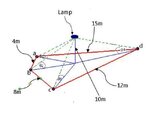other-side-of-d-moon
Advanced Member level 4

Hello there !
I need you help to get a algorithm or any tool to calculate the the light angles received at points a b c d, whenever i changed the lamp position.

Please note : distance of the blue lines ( from the main spot light to the points a b c d ) are variables not fixed, that is why i said the position of the lamp is not fixed.
regards
I need you help to get a algorithm or any tool to calculate the the light angles received at points a b c d, whenever i changed the lamp position.

Please note : distance of the blue lines ( from the main spot light to the points a b c d ) are variables not fixed, that is why i said the position of the lamp is not fixed.
regards
Last edited:



